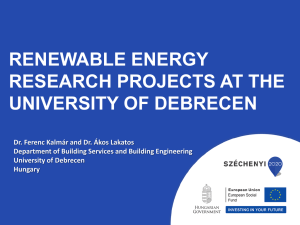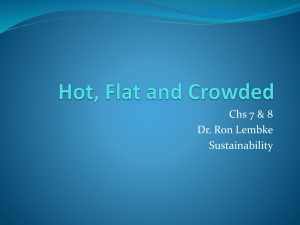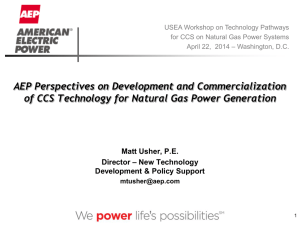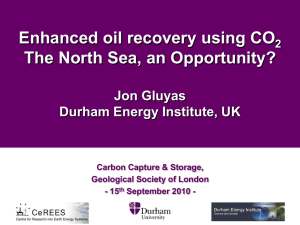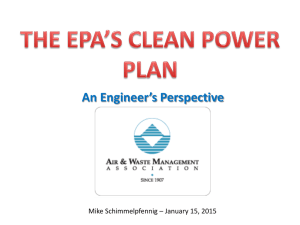IEAGHG Weyburn-Midale CO2 Project (Sacuta and Anderson)
advertisement
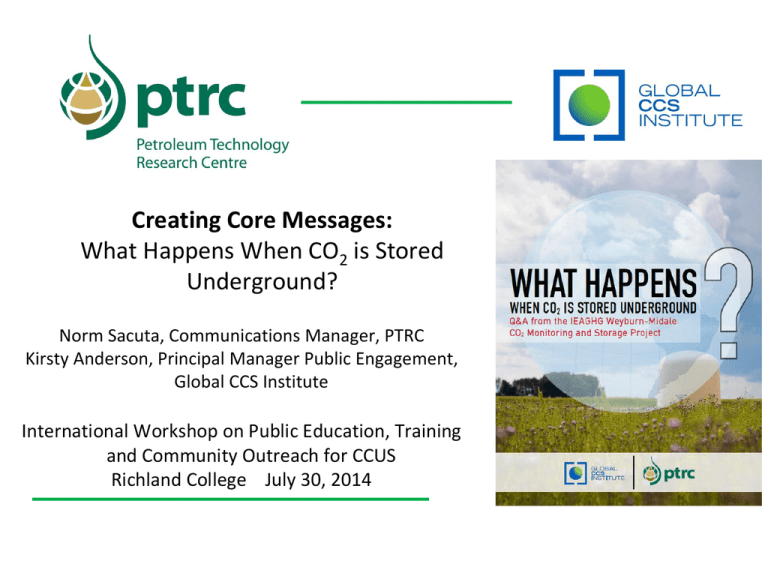
Creating Core Messages: What Happens When CO2 is Stored Underground? Norm Sacuta, Communications Manager, PTRC Kirsty Anderson, Principal Manager Public Engagement, Global CCS Institute International Workshop on Public Education, Training and Community Outreach for CCUS Richland College July 30, 2014 IEAGHG Weyburn-Midale CO2 Monitoring & Storage Project (WMP) 2000 to 2012 Commercial EOR operations in Weyburn and Midale oilfields utilise anthropogenic CO2 Over 25Mt of CO2 injected and stored since 2000 WMP has used these sites to study technical aspects of CO2 geological storage Best Practices Manual • • • • • • • • Characterization Performance Predictions Geochemical Monitoring Geophysical Monitoring Performance Validation Well Integrity Risk Assessment Community Outreach Joint Global CCS Institute – PTRC Project “Creating Core Messages” Initial Questions: • What do the Weyburn results tell us about the main questions often raised by the general public about CCS? • Is there a way of taking Weyburn knowledge and experience and making it understandable and engaging for the general public and useful to other CCS project developers? D o w n Phase change h o l e m o n i t o r i n g well heads aquifer TLA’s supercritical CO2 fate corrosion Structural trapping Joint Global CCS Institute – PTRC Project “Creating Core Messages”: Process Initial Process: • Review 2009 stakeholder results from the Weyburn Project • Identify key questions raised by Weyburn Community • Literature, project and web review to identify other key questions • 48 most often raised questions identified “Creating Core Messages”: Focus Groups September 24–25, 2013 • Document Effectiveness • Information Needs Met • Trusted Information Sources • Intuitive Format • Appropriate Language • Illustration & Design • Material Recall “Creating Core Messages”: Focus Groups September 24–25, 2013 Negative Reactions to Booklet: more information needed • Information source – who does WMP represent, who is providing this information? • What if’s – of operations impacting personal safety and the environment • Long term security of storage Peer Review of Focus Group Results and Document, November 14, 2013 Communications experts from North America and Europe were invited to take part in a workshop to review the focus group research findings. The intent of the workshop was to share learnings from the focus groups and to review the document itself. •Kirsty Anderson (GCCSI) •Richard Fink (Empresa Communications) •Chris Smith (ENGO Network) •Lori Gauvreau (Schlumberger) •Dan Daly (EERC/PCOR) •Jonathan Tremblay (SaskPower) •Sallie Greenberg (Decatur/Illinois Geological Survey) •Aleana Young (PTRC, Aquistore) •Duncan Kenyon (Pembina Institute) •Twila Walkeden (Cenovus) •Jolene Goulden (PTRC) Expert Review Recommendations • More clearly spell out what WMP has to say that is of value. • Clearer definition of Weyburn as an EOR project required. • Document viewed as a source book for use by communicators on other projects and policy makers. • Parts of the EOR operations (such as capture in Beulah, transport, and injection) that were not part of the research should perhaps be excised entirely from the document. • Improvement and consistency in images across document. Revision Order and structure simplified: 1. Economics and Regulation removed as a category; question and answers re-ordered 2. Some Q & A removed 3. Clearly defining Weyburn as EOR, but identifying that measurement and monitoring of stored CO2 is applicable to CCS From four sections: 1. The Basics: CO2 2. Carbon Capture and Storage 3. CCS in your Community 4. CCS: Economics and Regulations To three: 1. The Basics 2. What Happens to CO2 Underground? 3. What Ifs? The Most Common Questions About CCS Reworked Questions, Answers and Images WHAT HAPPENS TO CO2 UNDERGROUND? PDF, online version and limited printed copies available on request Short, simple, research-supported answers to 46 of the most commonly asked questions about CCS, CO2 monitoring and storage Answers are based on the 12-years of research findings and experiences of the IEAGHG Weyburn-Midale CO2 Monitoring and Storage Project PTRC for the Global CCS Institute: Sacuta, Norm. What Happens to CO2 Underground?, Feb 2014, Global Carbon Capture and Storage Institute Limited, Melbourne. www.globalccsinstitute.com/publications/what-happens-whenco2-stored-underground-qa-ieaghg-weyburn-midale-co2monitoring-and The Q&A document was tested with two community reference groups and peer reviewed by a panel of public engagement experts A summary of the focus group and expert panel results are also available to download. WHAT HAPPENS TO CO2 UNDERGROUND? Introduction What is the Weyburn-Midale Project (WMP)? The basics: carbon dioxide (CO2) Carbon capture and storage (CCS) What happens to CO2 underground? 16. How do you store CO2 and how do you decide where CO2 can be stored? 17. How much CO2 can be stored at different locations? 18. How deep do you store CO2? 19. What do you mean by 'permanent storage' of CO2? 20. Does CO2 occur naturally underground, like water, oil and gas? 21. How does CO2 move underground? 22. How do you confirm the CO2 stays within the formation? 23. How does an underground storage site change when CO2 is injected? 24. How do you monitor the CO2 once it is underground? 25. How do you know where the CO2 will go? 26. How do you know if CO2 has leaked? 27. Does CO2 injection increase pressure in oil reservoirs? 28. How long will you need to monitor the CO2 once it is underground? 29. Are there regulations around CO2 storage? What ifs? the most common questions about CCS 30. How do you know CO2 storage is safe? 31. Will drinking water be affected by CO2 storage? 32. Will topsoil be affected by CO2 storage? 33. Will fish or wildlife be affected by CO2 storage? 34. Will land values be affected by CO2 storage? 35. What are faults and fractures? 36. Could injecting CO2 underground cause an earthquake? 37. What if there is an earthquake near a CO2 storage site? 38. What are wellbores and how do you maintain them? 39. How do you know that CO2 pipelines are safe? 40. What if there is a leak of CO2 from a pipeline? 41. How much noise and disruption do storage projects cause? 42. How visible is a CO2 storage facility? 43. If I own the mineral rights beneath my land, will I be paid for CO2 storage? 44. What if there is a leak of CO2 underground? 45. What if CO2 leaks 100 or 1000 years from now? 46. If there is a leak, who will be responsible for fixing it? Conclusion Questions? www.globalccsinstitute.com kirsty.anderson@globalccsinstitute.com http://ptrc.ca norm.sacuta@ptrc.ca
